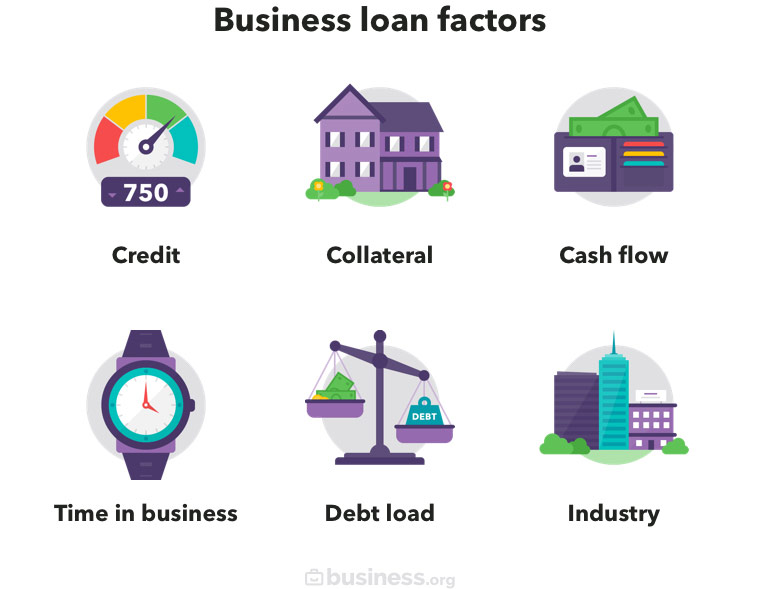We are committed to sharing unbiased reviews. Some of the links on our site are from our partners who compensate us. Read our editorial guidelines and advertising disclosure.
How to Choose a Business Loan
Getting a business loan sounds simple—until you realize how many types of loans exist and how many lenders offer those loans. Suddenly, you find yourself overwhelmed by choices that you didn’t even know existed.
We get it. That’s why we made this guide to choosing a small-business loan. Read on to see how you can find the right loan for your business.
Table of contents: choosing a business loan
How do small-business loans work?
While you have many loan choices, they all work on a similar principle: A lender gives you money. You repay the loan, plus fees and maybe interest, over a set amount of time.
Pretty simple, right? Well, it gets more complicated when you start considering your choices.
Like how you use your loan. We’ll talk about specific loan types more in a minute, but for now, you just need to know that some loans work better for certain business needs than others. For example, some loans work well for big one-time purchases and others work better for small, repetitive purchases.
By signing up I agree to the Terms of Use.
Another to consider is where you get your loan from. While traditional lenders, a.k.a. big banks, have ruled the loan scene for the past, well, pretty much forever, they now have competition in the form of alternative lenders, or online lenders. Traditional lenders tend to offer better deals on their loans, but alternative lenders have lower requirements for borrowers.
You also need to consider what you can qualify for. Young startups, for example, will want to look at various types of startup loans rather than applying for huge loans they can’t qualify for. Older businesses will likely qualify for better loans with lower rates.
And then there’s the specifics of a given loan. You need to consider all kinds of features:
- Loan amount
- Funding schedule
- Repayment term (how long you get to repay your loan)
- Repayment schedule
- Interest rates
- Loan fees
- Collateral requirements
So you have a lot of decisions to make. But before we get into the decision-making process, let’s take a moment to talk more about your loan options.
Types of business loans
Some things in life are one-size-fits-all. Business loans aren’t. They come in many shapes and sizes, so you need to understand what types exist and how they differ from one another. Ready for a crash course on business loans?
Loans for good credit
If you have good credit, you’ll not only have access to tons of loan options, but you’ll also get desirable loans with long terms and low rates.
These include basic term loans, which give you a large chunk of cash that you repay over a period of years. These often have low interest rates, but you will have to commit to spending years paying off your loan. Term loans have lots of uses, ranging from purchasing inventory to hiring new talent to upgrading your office.
Some term loans are more specialized, like real estate loans, which have even longer repayment terms and lower rates so you can purchase commercial real estate. Microloans, on the other hand, come in smaller amounts (less than $50,000) but may have higher rates. Because of their smaller sizes, microloans may be easier to get than their larger counterparts.
Then there’s the MVP of term loans: SBA loans. These loans get backed by the U.S. Small Business Administration, so they have some of the best rates and terms around. You’ll just have to meet specific credit requirements and then go through a lengthy application process to get them.
All these term loans give you financing as one up-front lump sum. If you’d prefer something that gives you continued access to funds, you can opt for a business line of credit or a business credit card. These forms of revolving credit let you use funds, repay them, and use them again. That makes business lines of credit and business credit cards great ways to improve cash flow or cover short-term expenses.
Loans for bad credit
Getting a loan with bad credit might require a little compromise—you won’t get the best terms or rates—but you’ll still get access to valuable funds that can help your business succeed.
Take equipment financing, for example. You can qualify for this type of term loan with bad credit because the equipment you purchase with the loan serves as collateral. You can get all sorts of equipment with these loans: office furniture, copy machines, drill presses—you name it. So if you need to replace or upgrade your business’s equipment, try equipment financing.
Merchant cash advances (MCAs), on the other hand, give you up-front cash that you repay (plus fees) through a fixed percentage of your credit card and debit card sales. The automatic payment process makes these loans viable for small businesses with bad credit, but be warned: MCAs have notoriously high APRs.
Then there’s invoice factoring and invoice financing, which let you use your unpaid invoices to get cash. With invoice factoring, you sell unpaid invoices to a lender. You get an up-front percentage of the invoice amount, and the lender gives you the rest (minus fees) after the invoice gets paid. With financing, you get a short-term loan for the amount of the unpaid invoice. Both forms can supplement your cash flow while you wait for customers to pay.
Choosing your business loan
So you have plenty of choices for your business loan—but what kind should you actually get?
Luckily, you won't have to figure that out all by yourself. We’re here to guide you. Here’s a step-by-step process for finding the right loan for your needs.
Step 1: Nail down why you need a loan
First, you need to decide exactly why you need a loan. How will a loan help your business grow? What specifically will you use the money on?
Your answers will narrow down the type of loan you need. If you need financing to improve cash flow, for example, you might decide on a line of credit. Or if you want to purchase a new building, you’ll definitely want a commercial real estate loan.
Your answers will narrow down the type of loan you need. If you need financing to improve cash flow, for example, you might decide on a line of credit. Or if you want to purchase a new building, you’ll definitely want a commercial real estate loan.
Some uses—like paying for marketing campaigns or purchasing inventory—may apply to many types of loans. But with this first step, you should be able to get at least a little closer to narrowing down your options.
Before we go on, though, some real talk: keep in mind that some reasons for getting a loan are better than others. If getting a loan will help you expand your business and increase your profit, that’s a pretty good reason. But if you’re getting a loan as a last-ditch measure to keep your business from going underwater, you should think twice about borrowing.
Do you really need a loan, or do you need to reevaluate your business’s spending and budget? Will a loan actually help your business recover and thrive, or will it be like putting on a Band-Aid when you’re bleeding out? The last thing you want to do is incur debt you can’t pay off.
So borrow wisely.
Your answers will narrow down the type of loan you need. If you need financing to improve cash flow, for example, you might decide on a line of credit. Or if you want to purchase a new building, you’ll definitely want a commercial real estate loan.
Some uses—like paying for marketing campaigns or purchasing inventory—may apply to many types of loans. But with this first step, you should be able to get at least a little closer to narrowing down your options.
Before we go on, though, some real talk: keep in mind that some reasons for getting a loan are better than others. If getting a loan will help you expand your business and increase your profit, that’s a pretty good reason. But if you’re getting a loan as a last-ditch measure to keep your business from going underwater, you should think twice about borrowing.
Do you really need a loan, or do you need to reevaluate your business’s spending and budget? Will a loan actually help your business recover and thrive, or will it be like putting on a Band-Aid when you’re bleeding out? The last thing you want to do is incur debt you can’t pay off.
So borrow wisely.
Remember: loans are just one of several small-business funding options. Don’t forget to consider other types of financing, like grants, crowdfunding, and investors.
Step 2: Figure out how much you need
Small-business loans come in lots of sizes—from hundreds of dollars to millions—so you’ll need to decide just what size you need. And despite what you might think, the answer is not “as much money as I can possibly get.”
It might sound obvious, but you’ll have to repay whatever you borrow. And a larger loan will likely mean bigger payments, which can hurt your cash flow. Plus, most lenders calculate interest and other fees as a percentage of your loan amount. A big loan will come with higher fees. So if you borrow money you don’t need, you’ll end up paying for that excess amount.
At the same time, you should make sure you don’t get a too-small loan. The last thing you want is to come up short on cash in the middle of a renovation project, for example.
Getting the wrong size loan is one of the most common mistakes business owners make when applying for funding. So try to find the right balance: large enough to cover your expenses, but small enough to stay manageable.
Many lenders take origination fees and other up-front fees out of your initial loan amount. So if you actually need $50,000, for example, you might want to get a slightly larger loan—say $55,000—to account for the cost of those fees.
Step 3: Take an honest look at your creditworthiness
By this point, you should have a rough idea of what kind of loan you want, but now you need to get real about what kind of loan you can actually get. Just because you want a $500,000 term loan doesn’t mean a lender wants to give you one, after all. You’ll have to meet certain business loan requirements.

Lenders will consider many factors as they evaluate your creditworthiness. For example, they might ask questions like these:
- What’s your personal credit score?
- How’s your business credit?
- What’s your annual revenue?
- How long have you been in business?
- Have you ever declared bankruptcy?
A traditional lender will likely want a pretty specific set of answers to these questions (think: 780; perfect; $200,000; five years; and no), whereas alternative lenders will have varying requirements.
Likewise, your creditworthiness will affect what kind of loan you get from a lender. While many lenders would hesitate to give a five-year loan to business owners with bad credit and a history of bankruptcies, for example, they might be more willing to extend a merchant cash advance.
Step 4: Explore your lending options
Now that you know what you need from a loan and what kinds of lenders you might qualify for, you can start looking specifically at lenders and their loan offerings.
So if you know you want invoice financing, you can start comparing lenders who offer that. Or if you know you have good enough credit to qualify for a traditional financial institution, you can begin comparing bank loan options.
As you compare, look at key small-business loan features like minimum and maximum loan amounts, terms, fees, and APRs.
In many cases, you won’t find one “best” loan—one might have a higher APR but also a better term, while another might have a lower APR but higher up-front fees—so you’ll have to decide what’s most important in your situation. Do you need low monthly payments? A big loan amount? A long term? That’s up to you to decide.
Step 5: Decide and apply
Once you prioritize your needs, you can decide on a lender and a loan. Then all that’s left is to submit a loan application. Make sure you gather any relevant documents (such as tax returns, bank statements, articles of organization, etc.) to speed up the process.
If you get accepted, then it’s time to use your newfound funding to build your business. Congratulations!
If you get denied, don’t give up; there’s plenty of fish in the sea. Or in this case, plenty of loans in the world. You can always apply somewhere else or choose a different type of loan.
Where to get a small-business loan
So now you know how to choose a loan. But what about where?
Well, you have lots of lenders to choose from. You’ve got big banks, online lenders, peer-to-peer lenders, and lending marketplaces.
No need to feel overwhelmed, though. Here at Business.org, we’ve reviewed the top loan providers for you. Here’s a quick look at our five favorites.
Data effective 7/7/22. At publishing time, rates and requirements are current but are subject to change. Offers may not be available in all areas.
*Does not represent the typical rate for every borrower, and other fees may apply.
The takeaway
Because loans vary so much—both in purpose and in features—you won’t find one business loan to rule them all. Choosing the right business loan will require you to carefully consider your business’s needs and creditworthiness.
But whether you have good credit or bad credit, there’s a loan for you. Just use the steps above to guide you in choosing your loan. Then apply, and get ready to use your financing to boost your business.
Want even more loan guidance? Take a look at our Ultimate Guide to Small-Business Loans.
Related reading
Disclaimer
At Business.org, our research is meant to offer general product and service recommendations. We don't guarantee that our suggestions will work best for each individual or business, so consider your unique needs when choosing products and services.



